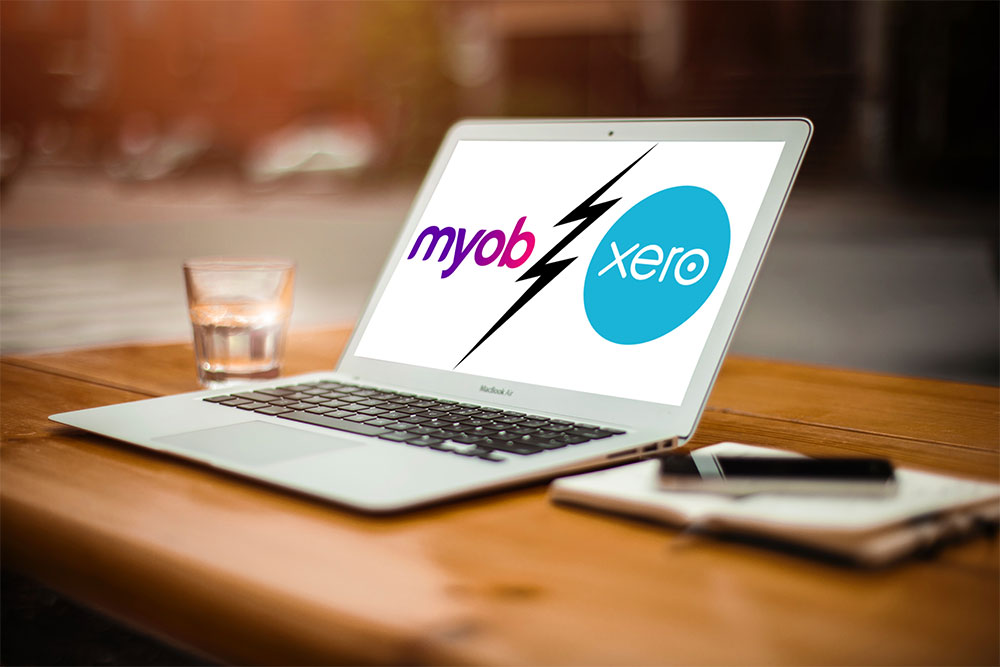Get us to call you
Fill in your details below to receive a call back quickly.
Fill in your details below to receive a call back quickly.
Fill in your details below to receive a call back quickly.
Fill in your details below to receive a call back quickly.


As your business grows, tracking your revenue and expenses in a spreadsheet is time consuming, limiting and quite inefficient.
And guess what?
Using accounting software will help you do a whole lot more within one system, and save you or your admin person a lot of time.
In this post, we’ll compare MYOB and Xero which are the two most popular packages in Australia.
But first…
or fill in our online enquiry form today to contact us.
First, let’s look at some of the reasons why your enterprise needs accounting software.
As a small business owner, you may have to wear different hats. One minute you’re in marketing, then you’re sending out invoices, then you’re managing operations, and then you’re doing the books. It can be stressful at times, right?
The good news, accounting software frees up some of your time by simplifying some tasks such as tracking expenses, processing transactions or even sending invoice reminders to your clients. As a result, you will have more time to spend on growing your business.
Whether it’s spreadsheets or paperwork, incorrect input of financial data will result in an inaccurate picture of your business’s financial health. With accounting software, you can track your company’s expenses and have a clear picture of where your money is going.
Sometimes as a small business owner, it’s easy to feel like you’re flying blind. You have too much on your plate and yet can’t see how it all fits into the bigger picture.
Enter accounting software. At the click of a button, you can generate crucial reports such as the balance sheet, cash flow statement and the profit and loss statement to gauge your financial health. In short, you have the information you need to make faster business decisions.
There are a number of things to consider before investing in accounting software. Some of these factors are:
Please remember there’s a fine line between cost and value. It’s important to do your homework and make sure you choose the accounting package which provides the best value, now and as you scale.
The software should be user-friendly. For instance:
Various accounting software packages have common features, and unique features, and your choice will depend on which one best suits your type of operation.
or fill in our online enquiry form today to contact us.
First, MYOB offers over 50 business management solutions ranging from accounting, payroll, CRM, payments, professional tax solutions to retail point of sale.
On the other hand, Xero connects with more than 1000 third-party apps and offers cloud accounting across Australia, New Zealand and the United Kingdom.
Here’s a useful comparison of the two:
| MYOB | Xero | |
| Monthly fee | Lite: $12Pro: $25 AccountRight Plus: $60 AccountRight Premier: $80 *Fees are subject to change, please visit here for the current prices | Starter Plan: $13.50 Standard plan: $27 Premium 5 plan: $35 Ultimate 10 plan: $55 *Fees are subject to change, please visit here for the current prices |
| Number of company accounts | The AccountRight Premier package allows up to 2 company accounts | One per subscription |
| Payroll | Lite: Optional payroll at $1.50 per person monthly and a maximum of two employees Pro: Optional payroll at $1.50 per person monthly and pay unlimited employees Account Right Plus: Includes payroll at no extra cost and pay unlimited employees Account Right Premier: Includes payroll at no extra cost and also pay unlimited employees | Starter: Payroll for 1 person Standard: Payroll for 2 people Premium 5 plan: Payroll for up to 5 people Ultimate 10 plan: Payroll for up to 10 people |
| Bank reconciliation | Lite package allows 2 accounts while the rest of the packages offer an unlimited number of accounts | Starter package doesn’t provide for reconciliation but the rest of the packages do |
| Invoicing | Create and send unlimited quotes and invoices | Starter package limits the number of invoices |
| Reporting | Lite package offers only tax and basic management reports while the rest of the packages provide advanced reports and analytics | You can generate a short-term cash flow and business snapshot report |
| Inventory management | Available in the AccountRight Plus and AccountRight Premier packages | Includes basic inventory management |
| Tracking Expenses | You can track income and expenses | Free for the first 2 months then $5 for one user per month |
| Foreign currency | Available in the AccountRight Premier package | Limited to the Premium 5 plan and the Ultimate 10 plan |
| Automated superannuation contributions | Available in all packages | Limited to the Premium 5 plan and the Ultimate 10 plan |
| Scan and store receipts | Available in all packages | Done through a third party app |
Lastly, to help you pick a winner in this MYOB vs Xero match, let’s jump into the advantages and disadvantages of each.
or fill in our online enquiry form today to contact us.
As shown above, both packages have their pros and cons. The choice you make depends on personal preferences such as the kind of business you run or your budget.
| Want to know more about MYOB for your business? SouthEast IT are experts in MYOB migration and support. Call us today and learn more about MYOB and how it can streamline your administrative functions and scale with you as you grow. |